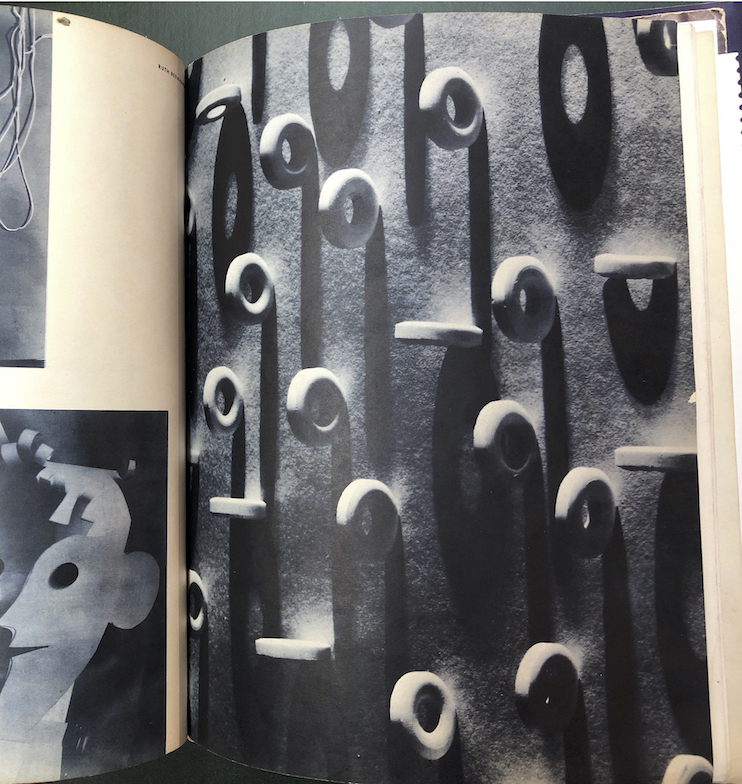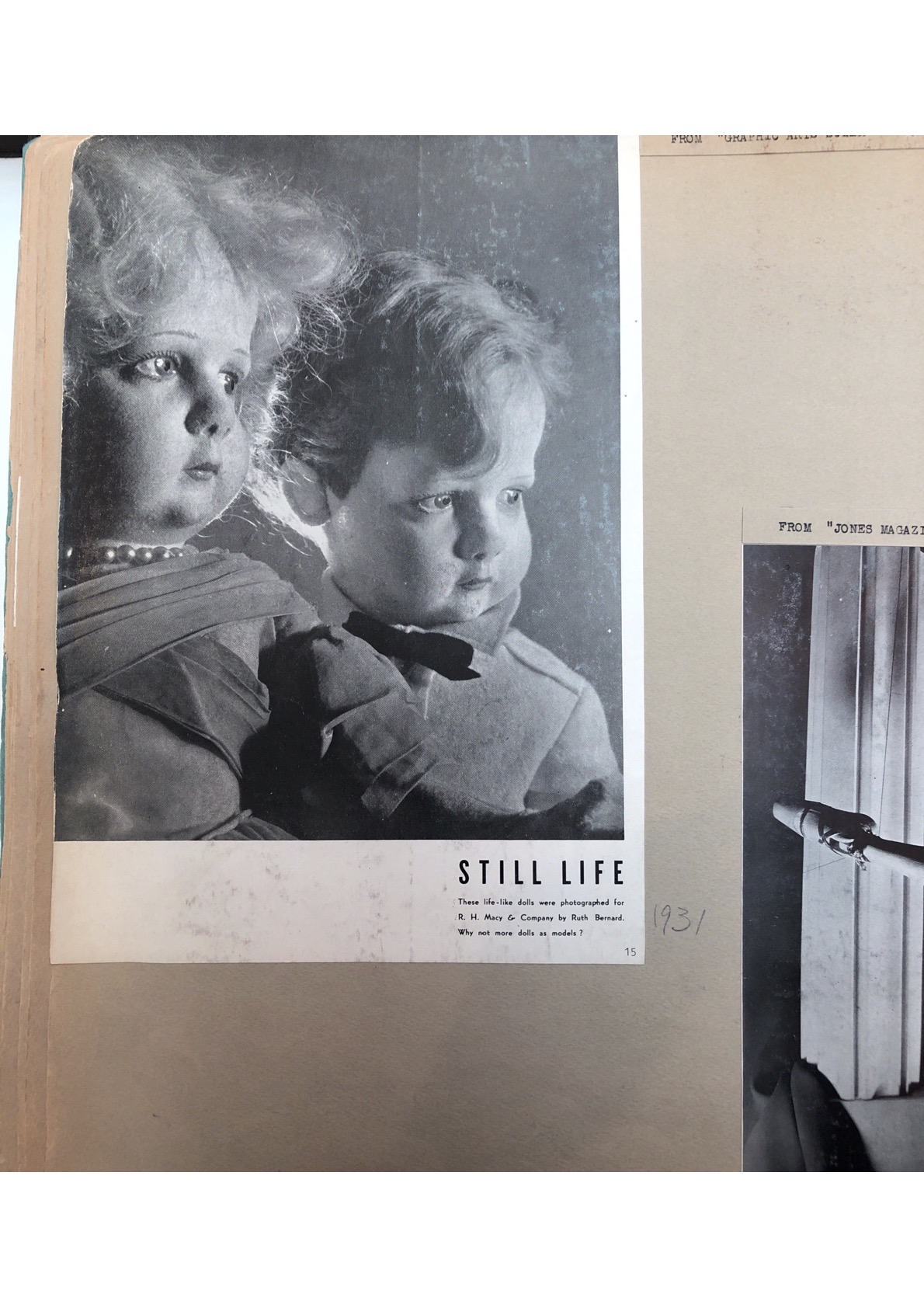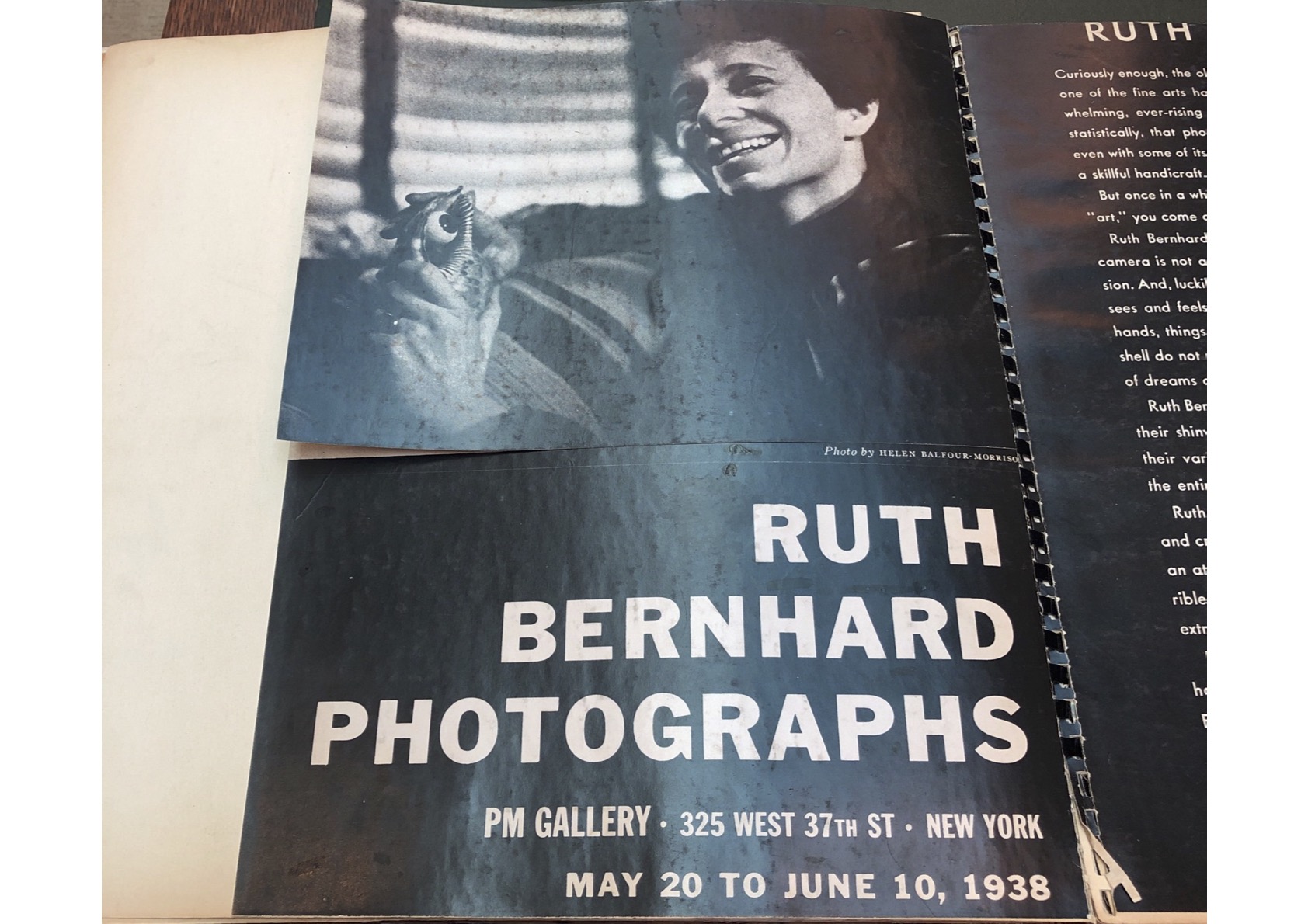Archive
Ruth Bernhard
- Ruth
- Bernhard
- 14-10-1905
- Berlin (DE)
- 18-12-2006
- San Francisco (US)
- Photographer
Ruth Bernhard was a German émigré photographer who lived in New York from the 1920s to the 1940s. Beside her series on female nudes, her place in the photography network, as well as in the New York queer scene, is unknown and understudied.
Word Count: 43

Lotte Jacobi, Ruth Bernhard, 1945, New York (© 2021. University of New Hampshire). 
Scrapbook and published work by Ruth Bernhard (Ruth Bernhard Archive, Special Collection Princeton University © Trustees of Princeton University). 
Lifesavers by Ruth Bernhard, published in Advertisment Arts, January 1931 (Ruth Bernhard Archive, Special Collection Princeton University © Trustees of Princeton University). 
Still Life of dolls for Macy’s by Ruth Bernhard, published in Graphic Arts, 1931 (Ruth Bernhard Archive, Special Collection Princeton University © Trustees of Princeton University). 
Ruth Bernhard, Eighth Street Movie Theater, Frederick Kiesler-Architect, New York, 1946 (Diversity Corner is licensed under CC BY-NC 2.0). 
Exhibition flyer for Ruth Bernhard Photographs, PM Gallery, 1938 (Ruth Bernhard Archive, Special Collection Princeton University © Trustees of Princeton University). 
Description of Ruth Bernhard Photographs exhibition, by Kurt Safranski, PM Gallery, 1938 (Ruth Bernhard Archive, Special Collection Princeton University © Trustees of Princeton University). Bernhard, Ruth. "Beachcombers Art – You don’t need a scientific interest in shells to get photographic fun and information from them." Popular Photography, November 1944, pp. 49–51; 101–102.
Displaced Visions. Émigré Photographers of the 20th Century, edited by Nissan N. Perez, exh. cat. The Israel Museum, Jerusalem, 2013.
Gilbert, George. The Illustrated Worldwide Who’s Who of Jews in Photography. G. Gilbert, 1996.
In Wonderland: The Surrealist Adventures of Women Artists in Mexico and the United States, edited by Ilene Susan Fort and Teresa Arcq, exh. cat Los Angeles County Museum of Art, Los Angeles, 2012.
Maloney, Tom. U.S. Camera Annual 1940. Random House, 1940,
Mitchell, Margaretta K., and Ruth Bernhard. Ruth Bernhard. Between Art & Life. Chronicle Books, 2000.
Recollections. Ten Women of Photography, edited by Margaretta K. Mitchell, exh. cat. International Center for Photography, New York, 1979.
Rosenblum, Naomi. A History of Women Photographers. Abbeville Press, 1994.
Ruth Bernhard: Known and Unknown, edited by Constance W. Glenn, exh. cat. University Art Museum California State University, Long Beach, 1996.
Ruth Bernhard. The Eternal Body. A collection of fifty nudes, edited by Margaretta Mitchell and Karen Sinsheimer, exh. cat. Princeton University Art Museum, Princeton, 2011.
Schenkar, Joan. The Talented Miss Highsmith. The Secret Life and Serious art of Patricia Highsmith. St. Martin’s Press, 2009.
Summers, Claude J., editor. The Queer Encyclopedia of the Visual Arts. Cleis Press, 2004.
Turin, Beatrice. "Where the World of Tomorrow Is But the Ghost of Yesterday." The Highway Traveler, vol. 13, no. 2, 1941, pp. 14–15; 42.
Women of Photography. A historical survey, edited by Margery Mann and Anne Noggle, exh. cat. San Francisco Museum of Art, San Francisco, 1975.
Word Count: 269
My deepest thanks go to the Princeton Library and Special Collection for providing me with information and granting the images rights on Ruth Bernhard as well as to the University of New Hampshire.
Word Count: 33
New York, US (1927–1935); New York, US (1938–1948).
Roosevelt Hotel, East 45th Street, Turtle Bay, Manhattan, New York City (residence, 1927); East 59th Street, Central Park South / Sutton Place, Manhattan, New York City (residence and workplace, 1927–1930); 59th West Street between 5th and 6th Avenue, Central Park South, Manhattan, New York City (residence and workplace, 1930–1932); Bleeker Street curve of the EL, Greenwich Village, Manhattan, New York City (residence and workplace, 1932–1934); Corner 34th East Street and Lexington Avenue, Kips Bay, Manhattan, New York City (residence and workplace, 1934–1935); across the Armory Regiment Building between Lexington Avenue and corner East 26th Street, Kips Bay, Manhattan, New York City (residence and workplace, 1938–1944); South Washington Square, Madison Square District, Manhattan, New York City (residence and workplace, 1944–1948).
- New York
- Helene Roth. "Ruth Bernhard." METROMOD Archive, 2021, https://archive.metromod.net/viewer.p/69/2948/object/5138-8102959, last modified: 17-12-2022.
-
Hermann LandshoffPhotographerNew York
Besides outdoor fashion shots, Hermann Landshoff was a portrait and street photographer. During his time in New York, he captured the cultural, artistic and intellectual émigré scene as well as his photographer colleagues.
Word Count: 33
Walter SandersPhotographerNew YorkWalter Sanders was a German émigré photographer. In 1938 he arrived in New York, where he worked from 1939 until the end of his life for the Black Star agency and, from 1944, for Life magazine.
Word Count: 33
Kurt SafranskiPicture AgentFounding MemberTeacherCartoonistPublisherIllustratorNew YorkKurt Safranski was one of the founding members of the Black Star photo agency, a teacher at the New School for Social Research and the author of photojournalistic articles and books.
Word Count: 31
Andreas FeiningerPhotographerWriterEditorNew YorkAndreas Feininger, was a German émigré photographer who arrived in New York with his wife Wysse Feininger in 1939. He started a lifelong career exploring the city's streets, working as a photojournalist and writing a large number of photography manuals.
Word Count: 39
Lisette ModelPhotographerNew YorkLisette Model was an Austrian-born photographer who lived in New York with her husband Evsa Model after emigrating from France. Her street photographs capturing the curiosities of everyday life quickly caught the interest of museums and magazines.
Word Count: 37
Fred SteinPhotographerLawyerNew YorkAlways accompanied by his camera, the German émigré photographer Fred Stein discovered New York City during the 1940s and 1950s. His pictures provide an human and multifaceted view of the metropolis.
Word Count: 31
Rolf TietgensPhotographerEditorWriterNew YorkRolf Tietgens was a German émigré photographer who arrived in New York in 1938. Although, in the course of his photographic career, his artistic and surrealist images were published and shown at exhibitions, his work, today, is very little known.
Word Count: 39
Lotte JacobiPhotographerNew YorkIn October 1935 the German émigré photographer Lotte Jacobi, together with her sister Ruth Jacobi, opened a photo studio on 57th Street. The two sisters had to leave their parents' photo studio in Berlin in the 1930s and emigrated to New York.
Word Count: 41
Ruth JacobiPhotographerNew YorkRuth Jacobi was a German-speaking, Polish-born photographer who emigrated in 1935 to New York, where she opened a studio together with her sister Lotte Jacobi. She later had her own portrait studio.
Word Count: 31
Fritz HenlePhotographerNew YorkFritz Henle was a German Jewish photographer who emigrated in 1936 to New York, where he worked as a photojournalist for various magazines. He also published several photobooks of his travels throughout North America and Asia.
Word Count: 35
Kurt KornfeldPublisherPicture AgentFounding MemberNew YorkKurt Kornfeld was a publisher and literary agent and a founding member of the Black Star photo agency in New York City after his emigration in 1936 to New York.
Word Count: 29
Ernest MayerPicture AgentFounding MemberPublisherNew YorkErnest Mayer was co-founder of the Black Star Publishing Company photo agency, which built a network for émigré photographers and the American magazine scene from the mid-1930s until the end of the 1950s.
Word Count: 34
Ruth StaudingerPhotographerCinematographerArt dealerNew YorkVery few and only fragmentary details can be found on the German émigré photographer Ruth Staudinger, who emigrated in the mid-1930s to New York City. Her nomadic life was also characterisedd by several changes of name along the way.
Word Count: 40
Carola GregorPhotographerSculptorNew YorkThe German émigré photographer Carola Gregor was an animal and child photographer and published some of her work in magazines and books. Today her work and life are almost forgotten.
Word Count: 30
Rudy BurckhardtPhotographerFilmmakerPainterNew YorkRudy Burckhardt was a Swiss-born photographer, filmmaker and painter who emigrated from Basle to New York City in 1935. He was well networked within the emerging Abstract Expressionist art scene of 1940s' and 50s'.
Word Count: 33
New York World's Fair postcard View of the Constitution Mall looking toward statue of George Washington and Trylon and PerispherePostcardNew YorkShortly after the arrival in New York in 1939, photographs by the German émigré Ernest Nash were used and reproduced for postcards of the New York’s World’s Fair.
Word Count: 29
Black Star AgencyPhoto AgencyNew YorkThe German émigrés Kurt S(z)afranski, Ern(e)st Mayer and Kurt Kornfeld founded Black Star in 1936. The photo agency established was a well-run networking institution in New York.
Word Count: 31
Leco Photo ServicePhoto LabNew YorkLeco Photo Service was a photofinishing lab, highly-frequented and a contact hub for émigré photographers and photo agencies during the 1930s and 1940s, as well as a provider of employment for women in the photo industry.
Word Count: 36
New School for Social ResearchAcademy/Art SchoolPhoto SchoolUniversity / Higher Education Institute / Research InstituteNew YorkDuring the 1940s and 1950s emigrated graphic designers and photographers, along with artists and intellectuals, were given the opportunity to held lectures and workshops at the New School for Social Research.
Word Count: 31
Norlyst GalleryGalleryArt GalleryNew YorkFounded in 1943 by the American painter and art collector Elenore Lust, the Norlyst Gallery represented a cross section of contemporary painting, photography and other media focusing on surrealist and abstract expressionist styles and promoting women artists and photographers.
Word Count: 38
Weyhe GalleryArt GalleryNew YorkOpened in 1919 by the German-born art dealer Erhard Weyhe opened a bookstore and gallery space specialised in contemporary European artists and was the first to specialise in prints.
Word Count: 28
JJK Copy-ArtPhoto LabPhoto StudioPhoto SupplierNew YorkJJK Copy-Art was a photo studio and photofinishing service founded in 1929 by the Jewish Austrian émigré James J. Kriegsmann (1909–1994) and was located at 165 West 46th Street.
Word Count: 26
SpiratonePhoto SupplierNew YorkSpiratone was a photo company and photo supplier founded in 1941 by the Austrian émigré family Hans (1888–1944) and Paula Spira (?–?) and their son Fred Spira (1924–2007).
Word Count: 24
American-British Art CenterArt CenterNew YorkThe émigré gallerist Ala Story left London for New York around 1940, where she co-founded the American-British Art Center, which introduced British and US artists to the public.
Word Count: 27
Werner WolffPhotographerNew YorkWerner Wolff was forced to leave Germany in 1936 due to his Jewish background and emigrated via Hamburg to New York, where he could follow his career as photographer and photojournalist.
Word Count: 30
Josef BreitenbachPhotographerNew YorkOn arriving in New York in 1941, the German photographer Josef Breitenbach tried to restart as a portrait, street and experimental photographer, as well as a teacher of photo-history and techniques.
Word Count: 30
Alexey BrodovitchPhotographerArt DirectorGraphic DesignerNew YorkAlexey Brodovitch was a Belarus-born émigré graphic artist, art director and photographer who, from 1933, worked in New York for Harper’s Bazaar magazine and at the New School for Social Research.
Word Count: 31
Vladimir BobritskyPainterScene DesignerGraphic ArtistMusicianIstanbulBobritsky worked at the Theatre des Petits Champs, where he successfully dealt with stage designs and costumes, at the same time he participated in the Union of Russian Painters in Constantinople.
Word Count: 31
Lilly JossPhotographerNew YorkLilly Joss was an émigré freelance photographer in New York. She worked for the Black Star photo agency and magazines and was also a portrait and theatre photographer.
Word Count: 28
YllaPhotographerNew YorkYlla was an Austrian-born photographer who emigrated to New York in 1941. Specialising in animal photography, she produced not only studio photographs, but also shot outside on urban locations in the metropolis.
Word Count: 31
Ala StoryGalleristCuratorArt CollectorMuseums DirectorLondonOriginally from Vienna, Ala Story worked for galleries such as Redfern and Storran, opened the Stafford Gallery in 1938 and developed it into the British Art Centre.
Word Count: 26